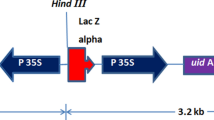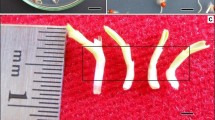Abstract
Agrobacterium rhizogenes strain LBA9402 was used to transformPinus halepensis embryos, seedlings and shoots. Mature embryos exhibited susceptibility to the agrobacterium as monitored by β-glucurortidase (GUS) expression, with more than 85% showing considerable transient GUS expression in the radicle. GUS expression was also observed in cotyledons, but at a lower rate of about 24% of the embryos (1–5 spots/embryo). Stable transformation was evidenced by the regeneration of GUS-expressing roots and calli from infectedP. halepensis seedlings. Inoculum injections into intact seedling hypocotyls induced callus and root formation at the wound sites in 64% of the seedlings. Dipping seedling cuttings in a bacterial suspension resulted in adventitious root formation in 7I% of the seedling cuttings, all of which expressed GUS activity. Adventitious shoots, that were induced on 2.5-year-old seedlings by pruning and spraying with 6-benzylaminopurine, were infected by injecting of bacterial suspension into their basal side. Two months later, adventitious roots and root primordia regenerated in 74% and 40% of 2- and 5-month-old shoots, respectively. Non-transformed shoots, either without or with auxin application, failed to form roots. Polymerase chain reaction and Southern blot analyses confirmed theuidA-transgenic nature of the root and callus, as well as the presence ofrolC androlB genes in roots from infectedP. halepensis seedlings.
Similar content being viewed by others
Abbreviations
- BA:
-
6-benzylaminopurine
- NOS:
-
nopaline synthase
- PCR:
-
polymerise chain reaction
- EtOH:
-
ethanol
- GUS:
-
β-glucuronidase
- NPTII:
-
neomycin phosphotransferase II
- CaMV:
-
cauliflower mosaic virus
- X-gluc:
-
5-bromo-4-chloro-3-indolyl β-D-glucuronic acid
References
Ahuja MR (1988) In: Ahuja MR (ed) Somatic cell genetics of woody plants. Kluwer Academic Publishers, Dordecht, pp 83–101
Akiyoshi DE, Morris RO, Hinz R, Mischke BS, Kosuge T, Garfinkel FJ, Gordon MP Nester EW (1983) Proc Natl Acad Sci USA 80: 807–811
Anderson AR, Moore LW (1979) Phytopathology 69: 320–323
Bergmann BA, Stomp A-M (1992) Phytopathology 82: 1457–1462
Bevan M (1984) Nucl Acids Res 12: 8711–8721
Black RC, Kuleck GA, Binns AN (1986) Plant Physiol 80: 145–151
DeCleene M, Deley J (1976) Bot Rev 42: 389–466
Dunstan DI (1988) Can J For Res 2: 1497–1506
Gladfelter HJ, Philips GC (1987) Plant Cell Reports 6: 163–166
Graves AE, Goldman SL, Banks SW, Graves ACF (1988) J Bacteriol 170: 2395–2400
Hakman I, von Arnold S (1985) J Plant Phys 121: 149–158
Hooykaas-Van Slogteren GMS, Hooykaas PJJ, Schilperoot RA (1984) Nature 311: 763–764
Inze D, Follin A, Van Lijsebettens M, Simones C, Genetell C, Van Montagu M, Schell J (1984) Mol Gen Genet 194: 265–274
Jefferson RA, Wilson KJ (1991) In: Gelvin SB, Schilperoort RA, Verma DP (eds) Plant Mol Biol Manual, Kluwer Academic Publishers, Belgium, B14, pp. 1–33
Kado CI (1991) Critical Reviews in Plant Sciences 10: 1–32
McAffe BJ, While EE, Pelcher LE, Lapp MS (1993) Plant Cell Tissue and Organ Culture 34: 53–62
Morris JW, Castle LA, Morris RO (1989) Physiol Mol Plant Pathol 34: 451–461
Murashige T, Skoog F (1962) Physiol Plant 15: 473–497
Schäfer W, Görz A, Kahl G (1987) Nature 327: 529–532
Schmülling T, Fladung M, Grossmann K, Schell J (1993) The Plant J 3: 371–382
Sederoff R, Stomp A-M, Chilton WS, Moore LW (1986) Bio/Tech 4: 647–649
Smith CO (1942) Phytopathology 32: 1005–1009
Stachel SE, Messens E, Montagu MV, Zambryski P (1985) Nature 318: 624–629
Stomp A-M, Loopstra C, Chilton WS, Sedroff RR, Moore LW (1990) Plant Physiol 92: 1226–1232
Tepfer D (1990) Physiol Plant 79: 140–146
Tzfira T, Ben-heir H, Vainstein A, Altman A (1996) Plant Cell Reports (in press)
Wang H, Qi M, Cutler AJ (1993) Nucl Acids Res 21: 4153–4154
Ya'ari A (1995) M.Sc. Thesis (The Hebrew University of Jerusalem, Israel, Hebrew with English summary)
Yarnitzki O (1995) M.Sc. Thesis (The Hebrew University of Jerusalem, Israel, Hebrew with English summary)
Author information
Authors and Affiliations
Additional information
Communicated by H. Lörz
Rights and permissions
About this article
Cite this article
Tzfira, T., Yarnitzky, O., Vainstein, A. et al. Agrobacterium rhizogenes-mediated DNA transfer inPinus halepensis Mill.. Plant Cell Reports 16, 26–31 (1996). https://doi.org/10.1007/BF01275443
Received:
Revised:
Issue Date:
DOI: https://doi.org/10.1007/BF01275443




